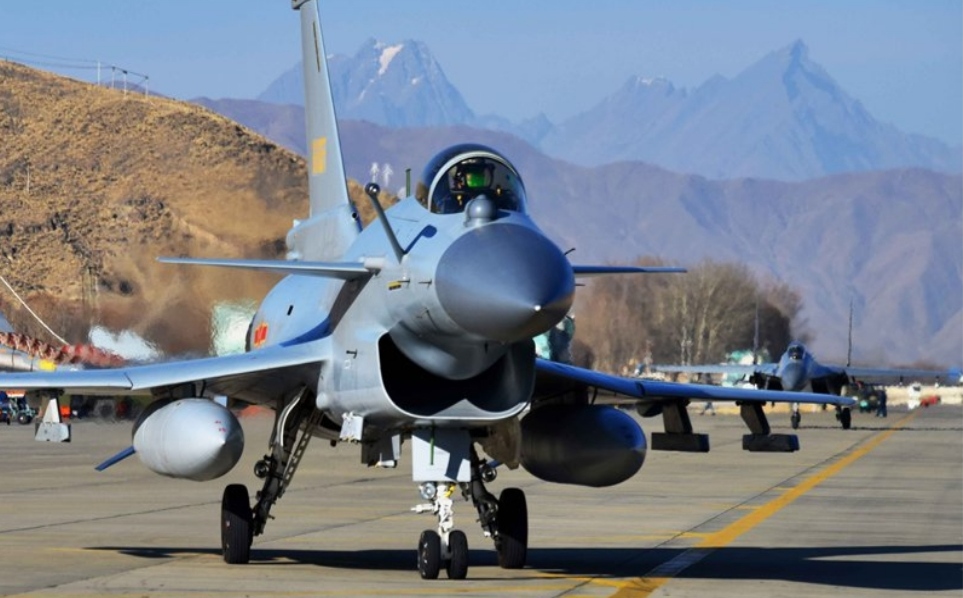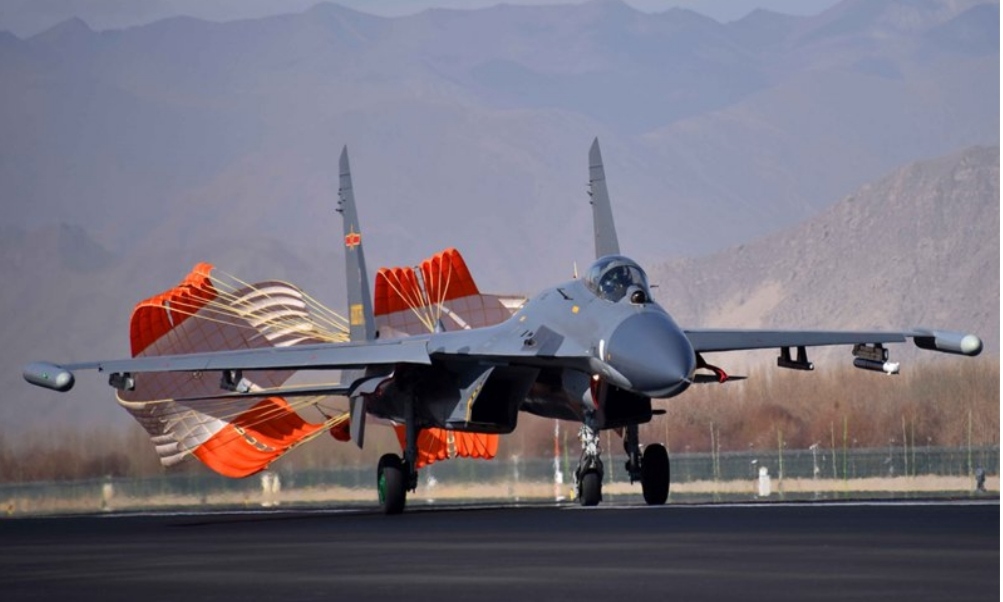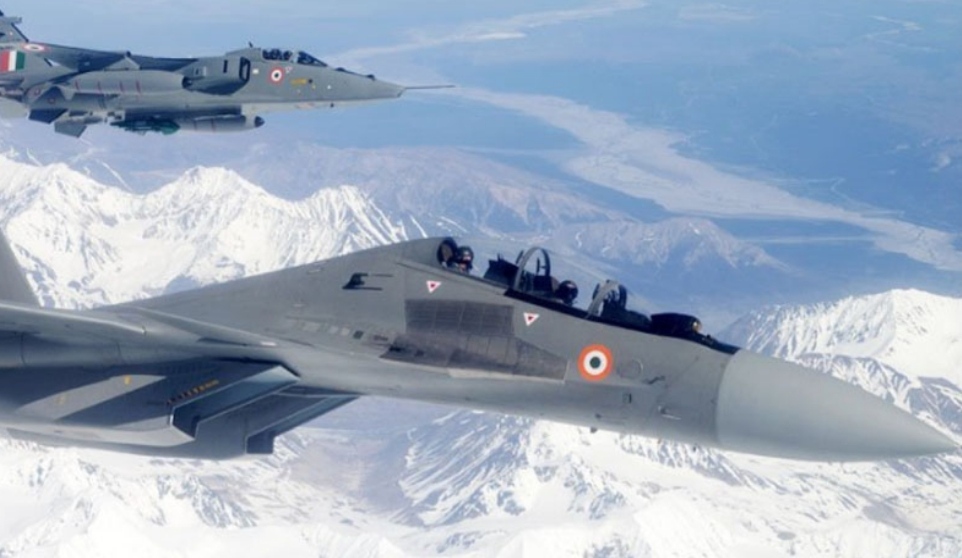China Upgraded Airspace Defense In Western Theatre No Match Against India

A J-10 fighter jet attached to an aviation brigade of the air force under the PLA Western Theater Command

A J-11 fighter jet attached to an aviation brigade of the air force under the PLA Western Theater Command
China has upgraded its Western Theater Command in order to confront and intimidate India, according to the views of a few military specialist after photographs of a J-10 jet flying over the high-altitude plateau in western China were released by the People’s Liberation Army (PLA).
The jets are attached to an aviation brigade of the air force under the PLA Western Theater Command. The Western Theater Command is mainly responsible for mountain warfare at the LAC area with India. It is significant for China to strengthen control of airspace over the Tibetan mountainous region, said a Chinese military expert
“Strengthening the 3.5-generation fighter jets or even stationing more advanced fighters in the Western Theatre Command has been urgent for the PLA,” said a PLA spokesperson adding that such upgrades have been usually first Carried out in south and east theatre commands.
As per the PLA website, it feels that India possesses only 3rd-generation fighter jets and thus China’s stationing of its 3.5-generation jets would be able to deal with any current threat from India. “With India importing new jets, China will continue strengthening its fighter jets in the Western Theatre Command with J11 s,” was however added by a Chinese military analyst.
However the picture is quite different on ground when you compare the two air forces. Aerial combat is likely to be a deciding factor in case of a potential war between India and China. Much of the battlefront is located high in the Himalayas, an area with limited ground accessibility.
 IAF has an estimated 325 fighter aircrafts deployed across the Himalayan Front opposite the Chinese Western Theatre Command along the LAC on the Indo Tibetan Border. It has a number of large air bases in the plains quite close to the LAC between India and Tibet, apart from Leh and Thois in the High altitude area.
IAF has an estimated 325 fighter aircrafts deployed across the Himalayan Front opposite the Chinese Western Theatre Command along the LAC on the Indo Tibetan Border. It has a number of large air bases in the plains quite close to the LAC between India and Tibet, apart from Leh and Thois in the High altitude area.
In addition IAF has also added a network of Advanced Landing Grounds (ALGs), which are small air fields in forward locations to provide staging grounds and supporting hubs for strike and logistic missions.
IAF has three air commands opposite the Western Theatre Command of the Chinese.In the Western Air Command, the IAF possesses around over 100 fighters, many major bases besides 5 ALGs, close to Tibetan areas and dedicated for this border. The Central Air Command features over 125 fighters, a couple of bases, and one ALG.
The Eastern Air Command again hosts over 100 fighters, a number of bases and 9 ALGs. Most importantly, bases though located in the plains are very close to Tibetan border with Arunachal, thus mobilization time is shortened and so it limits the prospect of a successful Chinese cross-border strikes.
The Chinese PLAAF, on the other hand, firstly suffers from a numerical disparity to the IAF in the Tibet region. Though the Western Theater Command has assumed control of all regional strike aircrafts, in the Tibet region opposite India, the theatre AF has just around 157 fighters and a varied number of drones.
This includes an estimated 20 GJ-1/WD-1K precision strike UAVs, 12 WD-1 ground attack and reconnaissance UAVs, 12 WD-1 precision strike UAVs, and 8 EA-03 reconnaissance and electronic warfare UAVs.
Secondly China has just eight airbases / airfields in Tibet which are relevant to India strike missions. A majority of these are civilian airports that can be commandeered in wartime.
Then there are other comparative weaknesses which permeate the PLAAF’s posture against India. On a strict comparison of available fighters, their J10 as noted above by the Chinese themselves is only a 3.5 generation fighters. Authoritative assessments hold that China’s J-10 fighter is technically comparable to India’s MiG27 which have since retired.
The IAF Bisons MiG21is fully capable of knocking out any J10 as it did to a much superior F16. The Indian Su-30MKI and Mirage 2000 on the other hand are much superior to all theatre Chinese fighters, including the new J-11 and Su-27 models.
China hosts a total of around 101 4th-generation fighters in the theatre, of which a proportion must be retained for defence of other borders, while India has around 122 of its comparable models, solely directed at China.
The most damaging factor the Chinese face are the high altitude of Chinese air bases in Tibet and Xinjiang, plus the generally difficult geographic and weather conditions of the region. It means that Chinese fighters are limited to carrying around less than half of their designed payload and fuel. During day time with just one degree rise in temperature this capacity gets further reduced drastically.
In-flight refueling would be required for PLAAF forces to maximize their strike capacity. However Re fuellers will themselves be carrying much reduced fuel load. Also they cannot refuel more than two aircrafts at a time. Finally the numbers of re fuellers are very much limited.
China had only inducted 15 such tanker aircraft nationally as of 2017, meaning only a handful of its forces will benefit from this solution. Against these underpowered fighters, IAF forces will launch from bases and airfields unaffected by these geographic conditions, with maximum payload and fuel capabilities.
The most significant PLAAF forward air bases and airfields in Tibet region border are located at Hotan, Lhasa/Gonggar, Ngari-Gunsa, and Xigaze. These are highly vulnerable to a dedicated Indian offensive using fighters and missiles.
Ngari-Gunsa and Xigaze reportedly have no hardened shelters or blast pens for their aircraft, which sit in the open. Lhasa/Gonggar has recently developed hardened shelters able to protect up to 36 aircraft, while Hotan reportedly hosts “two aircraft shelters” of unknown capacity.
An Indian early strike mission to incapacitate these four Tibetan bases—and achieve air superiority over them—would compel China to rely more upon aircraft from its rear-area bases in China, exacerbating its limited fuel and payload problems many more times
Moreover, China lacks the redundancy and related force survivability compared to India in their comparative numbers of regional airbases. In sum, India has a much stronger regional air position, with “a large number of airfields in the east and west, so even if some airfields are down, operations can continue from other locations.
PLAAF training and experience shortcomings that are not shared by the IAF amplify China’s air disadvantage. Recent PLAAF exercises with unscripted scenarios have found that pilots are excessively reliant upon ground control for tactical direction.
In unanticipated combat scenarios, this dependence on explicit control tower guidance becomes extreme, while “ground commands” are simultaneously often unable “to keep up with the complex and changeable air situation. This suggests that PLAAF combat proficiency is significantly weaker than often estimated. They will be facing a nightmarish situation worse than Galwan.



